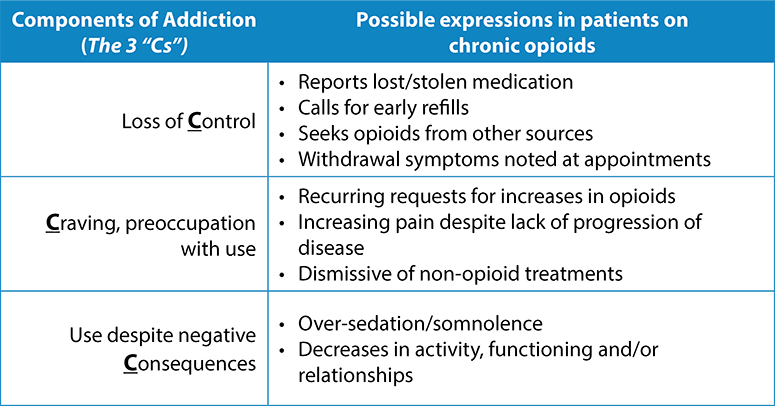Behaviors
People who are misusing prescription drugs may exhibit one or more of the following behaviors:
- Taking higher doses than prescribed
- Excessive mood swings
- Changes in sleeping patterns
- Poor decision making
- Seeking prescriptions from more than one doctor.
For Parents
LockYourMeds/NC lists more telltale behaviors that may signal misuse of substances in teens and young adults.
Language may be another cue. Drugs usually have street names, for example, “Captain Cody” for codeine, and there are many slang terms for drug use behaviors. Lock Your Meds has a primer on some of the slang young people may use, as well as a list of commonly misused drugs and examples of their street names.
Providers
The National Institute of Drug Abuse provides a table listing the three components of addiction: loss of control, craving and preoccupation with use, and use despite negative consequences (the “Three Cs”) and possible signs or symptoms of each that may indicate an opioid use problem.

(Credit/link: https://www.drugabuse.gov/sites/default/files/files/RecognizingOpioidAbuse.pdf)
Dentistry Today has a helpful guide for dentists, who are the main prescribers of opioids to patients aged 10 to 19 years: Helping Patients With Opioid Addiction.
Pharmacists
Pharmacists are often one of the most accessible members of the health care team and can play a front-line role in the battle against opioid misuse. They can learn to spot signs of drug misuse (or diversion) and take actions that include checking prescription drug monitoring programs (PDMPs, such as North Carolina Controlled Substance Reporting System), initiates communication with prescribers, and communicating with patients about naloxone and treatment options.
Download the CDC’s Pharmacists on the Front Lines brochure.
Pharmacists can look for “red flags”
Signs that patients might be struggling with opioid use disorder or diverting medications include:
- Forged prescriptions (e.g. lack of common abbreviations or overly legible handwriting)
- Prescriptions originating from outside the immediate geographic area
- Altered prescriptions (e.g. multiple ink colors or handwriting styles)
- Cash payments
- Inconsistent or early fills
- Multiple prescribers
A detailed examination of the pharmacist’s role and “red flags” can be found in the Pharmacy Times article Don’t Ignore These Opioid Abuse Red Flags.
A coalition of medical, pharmacist, and supply chain stakeholder organizations released a consensus document highlighting challenges and “red flag” warning signs related to prescribing and dispensing controlled substance prescriptions. The goal is to provide health care practitioners with an understanding of their shared responsibility to ensure that all controlled substances are prescribed and dispensed for a legitimate medical purpose, as well as to provide guidance on which red flag warning signs warrant further scrutiny. See Stakeholders’ Challenges and Red Flag Warning Signs Related to Prescribing and Dispensing Controlled Substances.






